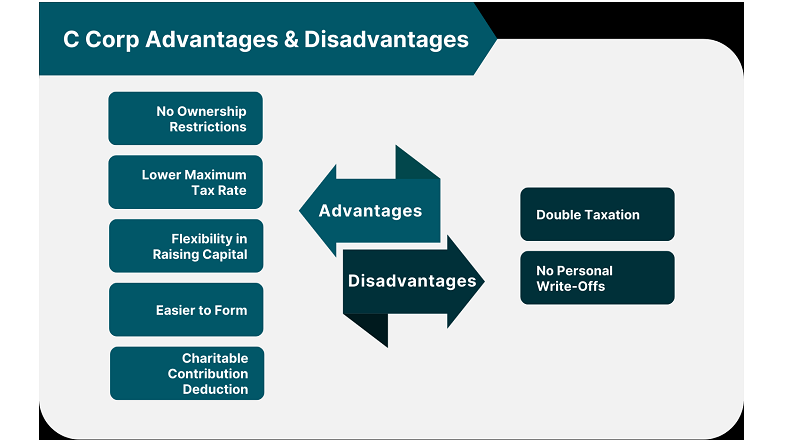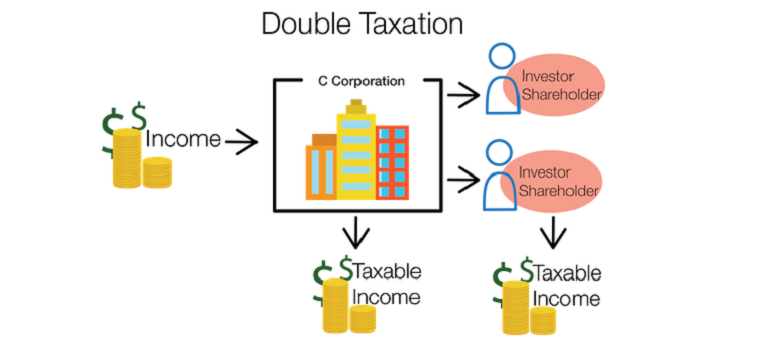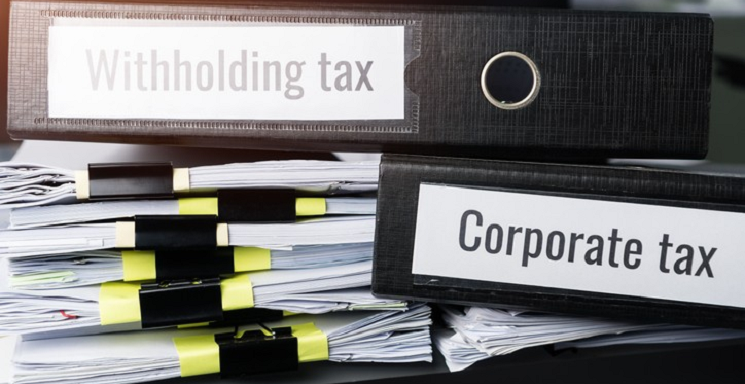
Welcome to the world of C-Corporations, a fascinating landscape where taxation takes a front seat in strategic business planning. If you are a small business owner considering this type of entity, or if you’ve already formed a C-Corporation, understanding the complexities of its taxation structure, particularly double taxation, is crucial. Double taxation refers to the way C-Corporations are taxed twice on their earnings – first at the corporate level, and then again on shareholder dividends. This dual layer of taxation can significantly impact your business’s bottom line, potentially swallowing a hefty portion of your profits.
Contents
Introduction to C-Corporations and Double Taxation
In the business world, different types of corporate structures have different advantages and disadvantages. C-Corporations, in particular, offer numerous benefits, including limitless potential for growth, perpetual existence, and protection for shareholders against business liabilities. However, they also come with their share of complexities, one of the most significant being the issue of double taxation.
Brief Explanation of C-Corporations
C-Corporations, often referred to simply as corporations, are legal entities separate from their owners. This separation gives them unique capabilities, such as the ability to issue stock, a characteristic that makes them attractive for businesses planning significant growth or aiming for a public listing. However, with these advantages come certain complications, especially when it comes to taxes.
Introduction to the Concept of Double Taxation
One of the defining characteristics of C-Corporations is double taxation. This term refers to the way corporations are first taxed on their income, and then shareholders are taxed again on the dividends they receive. It’s a critical aspect to understand for anyone involved in a C-Corporation, as it can have significant implications for the overall profitability and financial health of the business.
Importance of Understanding Double Taxation for Small Business Owners
If you’re a small business owner considering forming a C-Corporation, or you’ve already done so, it’s crucial to understand how double taxation works and how it may impact your business. Knowledge of this issue can help you strategize to mitigate its effects, maximize your profits, and ultimately drive your business toward greater success [1].

Understanding the Basics of C-Corporation Taxation
Before we get into the specifics of double taxation, it’s essential to understand how taxation works for C-Corporations in general. Grasping the fundamentals will give us a clear perspective on why double taxation occurs and set the foundation for later discussions on strategies to minimize it.
How C-Corporations are Taxed
Unlike other business entities, C-Corporations are considered separate tax entities by the Internal Revenue Service (IRS). As a result, they have a unique taxation system that separates the corporation’s income from its owners’ or shareholders’ personal income. This setup leads to what is known as ‘corporate income tax’ and ‘dividend tax,’ which combined, results in double taxation.
Introduction to Corporate Income Tax
The first layer of taxation for C-Corporations is the corporate income tax. This tax applies to the corporation’s profits – essentially, its revenues minus its business expenses. The IRS levies a flat tax rate on these profits. As of my knowledge cutoff in September 2021, this rate is 21%, but it’s always prudent to check the current rate as tax laws can and do change.
Explanation of Dividend Tax
The second layer of taxation occurs when a corporation decides to distribute its after-tax profits to shareholders in the form of dividends. These dividends are then taxed again, but this time on the shareholders’ personal tax returns. The rate of this tax depends on the shareholder’s personal income tax bracket and can vary widely. In essence, the same profit is taxed twice – first at the corporate level and then again at the individual level, thus creating double taxation [2].
In-Depth Look at Double Taxation in C-Corporations
With the basics of C-Corporation taxation under our belt, let’s now dive deeper into the intricacies of double taxation. Understanding how and why it occurs is essential to devising effective strategies to minimize its impact on your business.
Explanation of How Double Taxation Occurs in C-Corporations
As we’ve touched on earlier, double taxation arises from the distinct legal structure of C-Corporations. These entities are considered separate from their owners in the eyes of the law, which leads to them being taxed separately as well. Here’s a simplified sequence of events to illustrate the process:
- The corporation earns revenue.
- The corporation pays corporate income tax on its profits.
- The corporation distributes remaining after-tax profits to shareholders as dividends.
- Shareholders pay personal income tax on these dividends.
Therefore, the same money is effectively taxed twice – once at the corporate level and once at the individual level. This is the crux of double taxation.
Examples of Double Taxation
Consider a C-Corporation that made a profit of $100,000 in a given year. Assuming a corporate tax rate of 21%, it would pay $21,000 in taxes, leaving $79,000. If the corporation then distributes this amount as dividends to its shareholders, these dividends are subject to personal income tax. Suppose a shareholder in the 24% tax bracket receives a dividend. This person would pay 24% of the dividend amount in taxes, further reducing the actual profit they realize from the original $100,000 [3].
The Financial Implications of Double Taxation for Small Businesses
Double taxation can significantly impact a C-Corporation’s bottom line. The compounding effect of taxing profits twice can reduce the actual profits that reach the shareholders, making it a critical consideration for businesses. Small businesses, in particular, need to be aware of these implications because they can significantly affect growth and scalability.

Ways to Minimize Double Taxation in C-Corporations
While double taxation can seem like a daunting challenge for C-Corporations, several strategies can help reduce its impact. Remember, the goal isn’t to evade taxes – it’s to leverage legal avenues and financial planning tactics to ensure your corporation isn’t shouldering an unnecessary tax burden.
Retaining Earnings in the Business
One straightforward way to avoid double taxation is by retaining earnings in the business instead of distributing them as dividends. These retained earnings can be used for business operations, expansions, or investments, all of which are tax-deductible expenses. By doing so, the profits are only taxed at the corporate level, effectively eliminating the second layer of taxation.
Paying Salaries Instead of Dividends
Another viable strategy is to pay out profits as salaries to the corporation’s officers or employees, who are often also the shareholders in a small business. Salaries are tax-deductible for the corporation, reducing its taxable income. However, keep in mind that these salaries are subject to individual income tax and payroll taxes. Nevertheless, the overall tax burden may still be less than the double taxation scenario.
Investing in Tax-Exempt Securities
C-Corporations can also invest their profits in tax-exempt securities. The interest income from these securities is not subject to corporate income tax, reducing the corporation’s overall tax liability. This approach can be a part of a broader investment strategy, potentially offering both financial returns and tax advantages [4].
Using Stock Options and Bonus Payments
Instead of paying out dividends, a corporation might opt to provide employees with stock options or bonus payments, which can often carry different tax implications. Stock options, for example, are generally not taxed until the employee exercises the option. Similarly, bonus payments can be timed strategically for tax advantages.

Understanding the Role of Tax Planning in C-Corporations
Given the complexity of C-Corporation taxation, including double taxation, proactive tax planning plays a critical role. Regularly reviewing and adjusting your tax strategy can help you stay ahead of changes in tax laws and seize opportunities to reduce your tax liabilities.
The Importance of Regular Tax Planning
Tax laws can be dynamic, with changes occurring that can either help or hinder your business. Regular tax planning allows you to keep abreast of these changes and adjust your strategies accordingly. Moreover, it provides a platform to review your financial performance, enabling you to make informed decisions on issues such as retained earnings, dividends, and employee compensation [5].
How Tax Planning Can Help Minimize Double Taxation
Effective tax planning can help you navigate the choppy waters of double taxation. By exploring different strategies – such as retaining earnings, paying salaries, investing in tax-exempt securities, or providing stock options and bonuses – and assessing their impact, you can make informed decisions that minimize double taxation. The goal is to strike a balance between optimizing tax savings and meeting business growth objectives.
The Role of Tax Professionals in Tax Planning
Given the intricacies of C-Corporation taxation and the potential financial implications, it’s advisable to engage tax professionals in your planning process. Tax professionals stay up-to-date with the latest changes in tax laws and regulations. They can provide guidance on how to structure your corporation’s financials, plan for dividends and salaries, and make investment decisions that effectively minimize double taxation.
References
[1] Double Taxation of Corporate Income in the United States and the OECD
[2] What Double Taxation Is and How to Avoid It
[3] What Double Taxation Is and How It Works
[4] Double Taxation
[5] Double Taxation: What It Is and How to Avoid It
